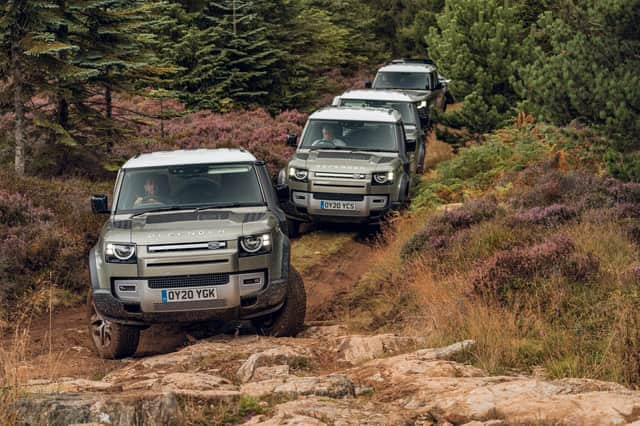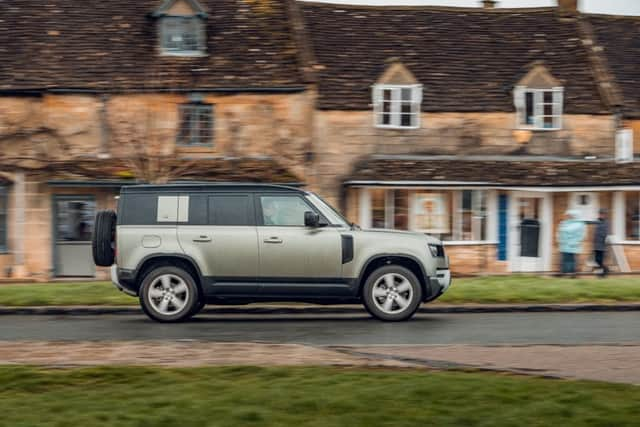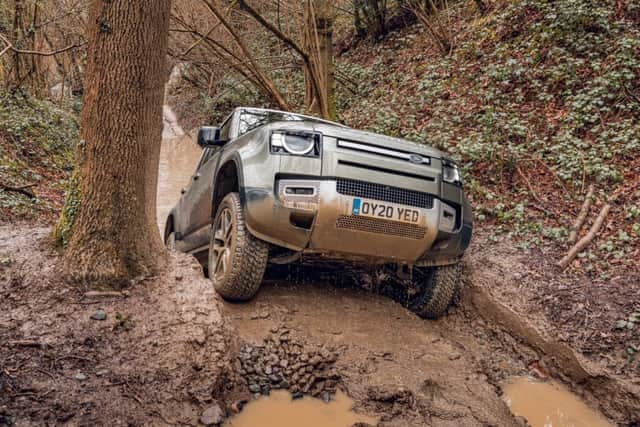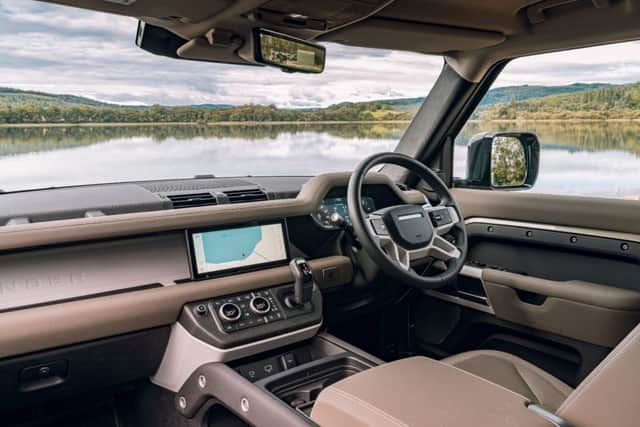Land Rover Defender review - Iconic 4x4 steps into the 21st century


You have to feel sorry for the team behind the new Land Rover Defender.
They were essentially told to go and reimagine one of the most iconic, best-loved vehicles of the last 70 years and make sure it kept the old fans happy while appealing to the discerning 21st-century buyer.
Advertisement
Hide AdAdvertisement
Hide AdPersonally, I’d have run for the hills but they are made of sterner stuff and what you see before you is the fruits of their labours - a car designed to evoke memories of the old one, match its envious reputation as a 4x4 and offer a refined, comfortable modern driving experience.
From the outside, the thinking is clear - emulate but modernise. The looks are divisive but they’ve grown on me a huge amount since the first images appeared, and in the metal it works. There’s an overly-styled Tonka toy vibe about it but it’s been done with commitment and consistency that make it irresistible. The chunky, almost cartoonish aesthetic has been followed through everywhere and it feels like a cohesive design package, not a gimmicky homage. But it definitely is a homage, from the bluff upright front end and rubberised grab handle on the dash to the tailgate-mounted spare tyre and tiny LED tail lights, this is meant to evoke memories of the old icon. It’s a cynical ploy but it’s so well executed that it’s hard to dislike.


The interior is as focused on emitting the rugged image as the exterior. There are exposed screw heads, heaps of open rubber-lined storage pockets, rubber floor mats and a tough part-leather, part woven textile upholstery that feels a lot more utilitarian than anything else in the Land Rover range. But there is also shared switchgear with other JLR vehicles that means this still feels like a 21st-century product. That’s emphasised by features such as the six cleverly placed USB sockets and the new internet-connected 10-inch Pivo Pro infotainment system.
Sadly, some of the materials, especially the lesser-noticed ones, don’t match the rugged image. A small example but the sort of thing that’s likely to break is the tablet mount/charging point in the back of the seats. It is a nice idea but the unit is made of thin, brittle plastic that doesn’t feel made to last. Likewise the optional sidepod luggage holder which looks good but feels very flimsy.
Advertisement
Hide AdAdvertisement
Hide AdI don’t want to get too hung up on comparing this model to the old car - it’s been four years since that old thing was killed off and although the name remains everything else is new. That said, this is a far bigger beast than the old one - longer, taller and wider. In some ways that’s a blessing. It means you’ve got somewhere to put your arms, for a start, and gives you a commanding view of the world around you. But it also means the car feels unwieldy on the narrow rural roads intended to be its home and trying to squeeze through countryside villages or twisty off-road trails can leave you fearing for the paintwork.
The extra size does, however, contribute to stellar practicality. In the tested five-seat version there’s loads of space in every direction in every seat. Things will get a bit cramped if you go for the optional front jump seat but if you choose the armrest/storage bin there’s loads of room on top and a deep well inside. There are storage and charging points left right and centre and the boot’s a healthy 646 litres, expanding to as much as 2,380l, with a deep, wide opening and tough rubber flooring. Towing capacity is 3,500kg and the Defender has a max payload of 900kg, including up to 300kg on the roof. The flat, broad windscreen and thin upright A pillars mean forward visibility is great and the large glasshouse all around makes it far easier to see out of than many modern cars.
Land Rover Defender 110 D240 S
- Price: £52,110 ((£62,830 as tested)
- Engine: 2.0-litre, four-cylinder diesel
- Power: 237bhp
- Torque: 317lb ft
- Transmission: Eight-speed automatic, permanent four-wheel-drive
- Top speed: 117mph
- 0-62mph: 8.7 seconds
- Economy: 31.7-29.6mpg
- CO2 emissions: 234-251g/km
That’s a huge help on road but also away from the Tarmac, where the Defender is imperious thanks to smart physical design and a wealth of digital assistants.
A lot of engineering work went into ensuring the Defender is the most capable car Land Rover has ever produced. Overhangs are short, ground clearance is high and a flat underbody protects components as well as improving aerodynamics. For stats geeks, the new Defender has approach, breakover and departure angles of 38 degrees, 28 degrees and 40 degrees respectively, can climb a 45-degree slope and wade through 900mm of water. With adaptive air suspension, it offers up to 291mm of ground clearance and 500mm of suspension articulation. In other words, this is still a proper 4x4.
Advertisement
Hide AdAdvertisement
Hide AdAt the wheel, the manual transmission and low-range shift levers are gone, replaced with a touchscreen and the very latest version of Land Rover’s Terrain Response 2 system. This uses dozens of sensors, cameras and a tonne of computing power to observe, measure and adapt to whatever surroundings you are in. There are drive modes for everything from gravel trails to sand dunes, rocky hillsides and wading. Each adapts the throttle, braking and traction control as well as the eight-speed automatic transmission with high and low range, lockable centre and rear diffs, and the optional air suspension. The Defender is also the first Land Rover to let you configure your own settings for Terrain Response if you think you know better than the computer.
That configurability will go some way to appeasing old-school off-roaders who want manual control over every element but the technology is so adept that virtually anybody could be let loose in auto mode without fear of getting stuck. That’s something we proved during several hours over the muddy hillsides and rocky woodland trails of Highland Perthshire which the Defender soaked up with barely a shrug.


If Land Rover was determined to maintain the old Defender’s off-road abilities, it was equally determined not to emulate its on-road behaviour. The old one was noisy, unrefined, heavy and didn’t “do” handling.
Happily, on the road it’s light years ahead of the original and you could easily use it every day and on long runs. The refinement and noise insulation is good, the ride is comfortable and the handling is acceptable. There’s still some lean but you learn to adapt to that. However, it’s not a huge lot better than the best of the current pick-ups. Something like the Ford Ranger is just as quiet and the Ranger and current Mitsubishi L200 both get close to the Land Rover in terms of body control. And if you buy a Defender expecting the refinement and handling of a “regular” SUV you’ll be disappointed. This is not a match for the BMW X5, Mercedes GLE or Volvo XC90.
Advertisement
Hide AdAdvertisement
Hide AdBut it’s not meant to be. The Defender straddles an odd middle ground between the school-run SUVs and “proper” utilitarian 4x4s. It’s too comfortable, high-tech, trendy and expensive to compete with workhorses like a pick-up truck but it’s more rugged and capable but less refined than the large SUVs that’ll never get a wheel dirty.
In truth, it’s a bit short on competitors. Capability-wise the Toyota Land Cruiser or Jeep Wrangler are both serious off-road performers. But the Toyota lacks the badge cachet or head-turning looks and the Wrangler is dismal on-road and feels cheap and tacky in comparison to the Defender. For a lot less money you could have a Suzuki Jimny that’ll do unbelievable things off road or a well-appointed yet rugged pick-up. But they’re not aiming for the same market, they don’t have the capacity for up to seven passengers, a proper secure boot or the LR’s looks or brand appeal. They are still commercial vehicles with nice toys whereas the LR is closer to those luxury SUVs.


It’s also closer to those luxury SUVs in price. Basic Defenders start at £43,625 for a 90 and £45,315 for a 110. Our S spec test car was £52,000 and came with air suspension, auto-dimming LED headlights, a suite of advanced driver aids, 360-degree cameras, sat nav and 19-inch alloys but had £10,000 of options added. This included fancy additions such as the more advanced configurable Terrain Response 2 with all terrain progress control (off-road cruise control) and the Clearsight rear view mirror/camera, as well as features you’d really expect to be standard on any £50k car such as keyless entry (£735) and front fog lights (£205).
Our mid-range test car was an early model with the slightly gruff but torquey four-cylinder D240 diesel engine. That, and all the four-pot diesels, is about to be replaced with a six-cylinder mild hybrid unit offering a smidge more power, better economy and lower CO2 emissions, plus the potential for two-wheel-drive for the first time. Coming at the same time is a plug-in hybrid version using a four-cylinder petrol engine and 105kW motor for 398bhp and an electric-only range of 27 miles.
Advertisement
Hide AdAdvertisement
Hide AdThat step towards electrification is a sign of how the new Defender has moved with the times. The name is the same but this is more rugged, capable and practical than its predecessor while featuring the comfort, refinement and technology that buyers expect in this day and age.
As a workhorse 4x4 it’s not cheap - although the commercial Hard Top version does start at £35,820 - but as a premium family SUV that can also handle anything the world can throw at you, it’s virtually unrivalled.
This article first appeared on our sister title The Scotsman